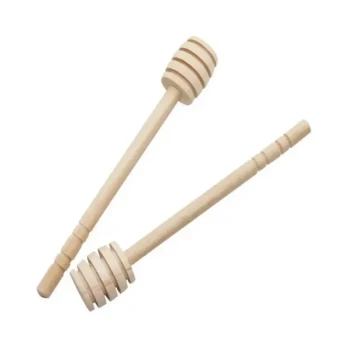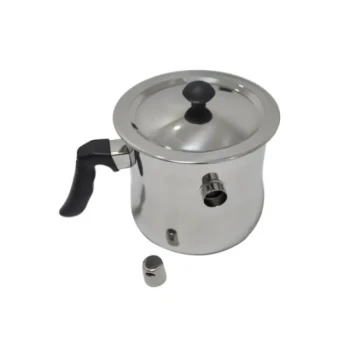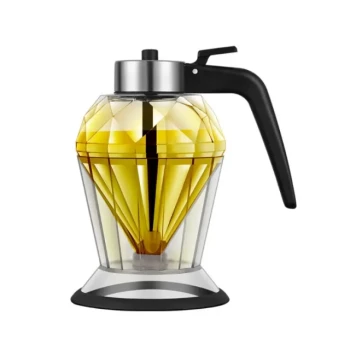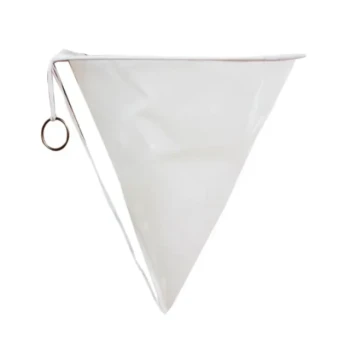In short, a honey warmer is a specialized heating device designed to gently and evenly raise the temperature of honey. Its primary purpose is to reverse the natural process of crystallization, returning hardened honey to a smooth, liquid state without damaging its delicate enzymes, flavor, or aroma. It is an essential tool for beekeepers and producers for maintaining honey quality and pourability.
The core problem is that honey naturally crystallizes and becomes solid. A honey warmer provides a controlled, low-temperature solution to re-liquefy it, ensuring the honey remains easy to filter, bottle, and serve while preserving its natural properties.

The Core Problem: Honey Crystallization
Why Honey Becomes Solid
Crystallization is a natural and expected process for raw honey; it is not a sign of spoilage. Over time, the glucose in honey separates from the water, forming tiny crystals that spread throughout the container.
This process eventually turns liquid honey into a semi-solid, granular state. The speed at which this happens depends on the honey's specific floral source and its glucose-to-fructose ratio.
The Challenge for Producers and Consumers
Once crystallized, honey is extremely difficult to pour, filter, or bottle. For beekeepers and commercial producers, this halts the entire processing workflow.
For consumers, it makes the honey hard to spread or mix into drinks. While still perfectly edible, its texture and usability are significantly compromised.
How a Honey Warmer Provides the Solution
Gentle, Controlled Heating
Unlike a microwave or stovetop, which create intense, uneven hot spots, a honey warmer is designed for low, slow, and consistent heat.
Many common designs, like silicone band heaters, wrap around the entire circumference of a bucket or pail. This delivers an even heat to the container's walls, gently melting the crystals without scorching the honey.
Preserving Honey's Natural Quality
Overheating honey is destructive. It can darken the color, alter the flavor, and destroy the beneficial enzymes and antioxidants that make raw honey so valuable.
A proper honey warmer operates at a precise, low temperature. This ensures it preserves the honey's natural essence and all of its inherent qualities.
Maintaining Ideal Viscosity for Handling
Warming honey not only re-liquefies it but also makes it less thick and easier to work with.
This improved pourability is critical for filtering out debris or wax particles after extraction and for ensuring a smooth, efficient bottling process.
Understanding the Pitfalls and Risks
The Danger of Uncontrolled Heat
Attempting to warm honey with improvised methods is a common mistake that can ruin an entire batch. Direct heat can easily burn the honey, introducing an unpleasant taste.
Using a microwave can create super-heated pockets that not only destroy the honey's beneficial properties but can also melt or damage plastic containers, leading to a significant mess.
Choosing the Right Tool for the Job
The most effective warmers are those specifically designed for honey containers. Wrap-around band heaters for 5-gallon buckets are an industry standard for a reason.
They apply heat exactly where it's needed—on the outside of the container—allowing the honey to liquefy gently from the outside in.
Making the Right Choice for Your Goal
A honey warmer is a tool of control, designed to manage honey's natural state for a specific purpose.
- If your primary focus is commercial production or serious beekeeping: A dedicated bucket warmer is an essential investment for maintaining product consistency and an efficient workflow.
- If your primary focus is hobbyist beekeeping: A warmer is an extremely valuable tool for restoring your harvested honey to a liquid state for bottling, sharing, or personal use.
- If your primary focus is home consumption: While not strictly necessary, a warmer can easily restore crystallized store-bought honey, ensuring none of it goes to waste.
By applying gentle and controlled heat, a honey warmer allows you to work with honey in its ideal liquid form without compromising its quality.
Summary Table:
| Aspect | Description |
|---|---|
| Primary Function | Gently re-liquefies crystallized honey. |
| Key Benefit | Preserves honey's natural enzymes, flavor, and aroma. |
| How It Works | Applies low, even heat to the container walls. |
| Ideal For | Commercial apiaries, distributors, and serious beekeepers. |
| Alternative Methods | Microwave or stovetop (not recommended, risks quality loss). |
Ensure Your Honey Flows Smoothly and Profitably
Crystallized honey doesn't have to slow down your operation. HONESTBEE supplies commercial apiaries and beekeeping equipment distributors with the reliable, high-quality honey warmers needed to maintain product quality and streamline your bottling process.
We help you:
- Preserve Quality: Our warmers use gentle, controlled heat to protect your honey's delicate properties.
- Boost Efficiency: Re-liquefy honey quickly and evenly to keep your production line moving.
- Reduce Waste: Ensure every last drop of your harvest is pourable and saleable.
Ready to upgrade your honey processing? Let's discuss the best warming solution for your business.
Contact HONESTBEE today for a quote!
Visual Guide
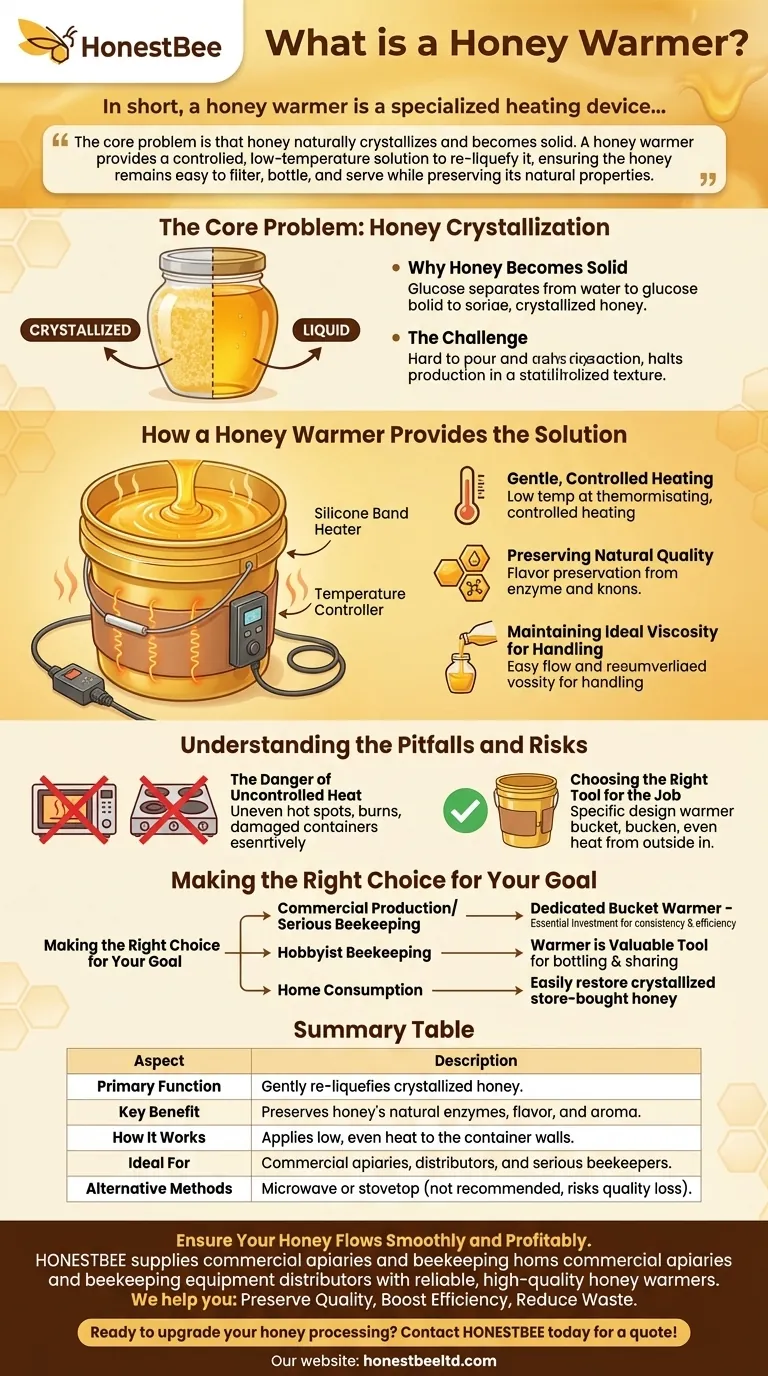
Related Products
- Honey Tank Heater Drum Heating Blanket for Honey Barrel
- 10L Stainless Steel Electric Honey Press Machine
- Electric Honey Press Machine for Squeezing Honey Comb Press Equipment
- HONESTBEE 72 Frame Industrial Electric Honey Extractor for Beekeeping
- Natural Wood Honey Dipper for Tea Coffee and Desserts
People Also Ask
- How to fix solidified honey? A Beekeeper's Guide to Gentle Re-liquefaction
- What are the benefits of a honey heating tank? Achieve Crystal-Clear, Market-Ready Honey
- How can crystallized honey be restored to a liquid state? A Beekeeper's Guide to Gentle Re-liquefaction
- Why is a honey bucket warmer considered a valuable tool for honey storage? Preserve Quality & Streamline Bottling
- How do you use a honey warmer? A Guide to Safe, Gentle Honey Decrystallization




